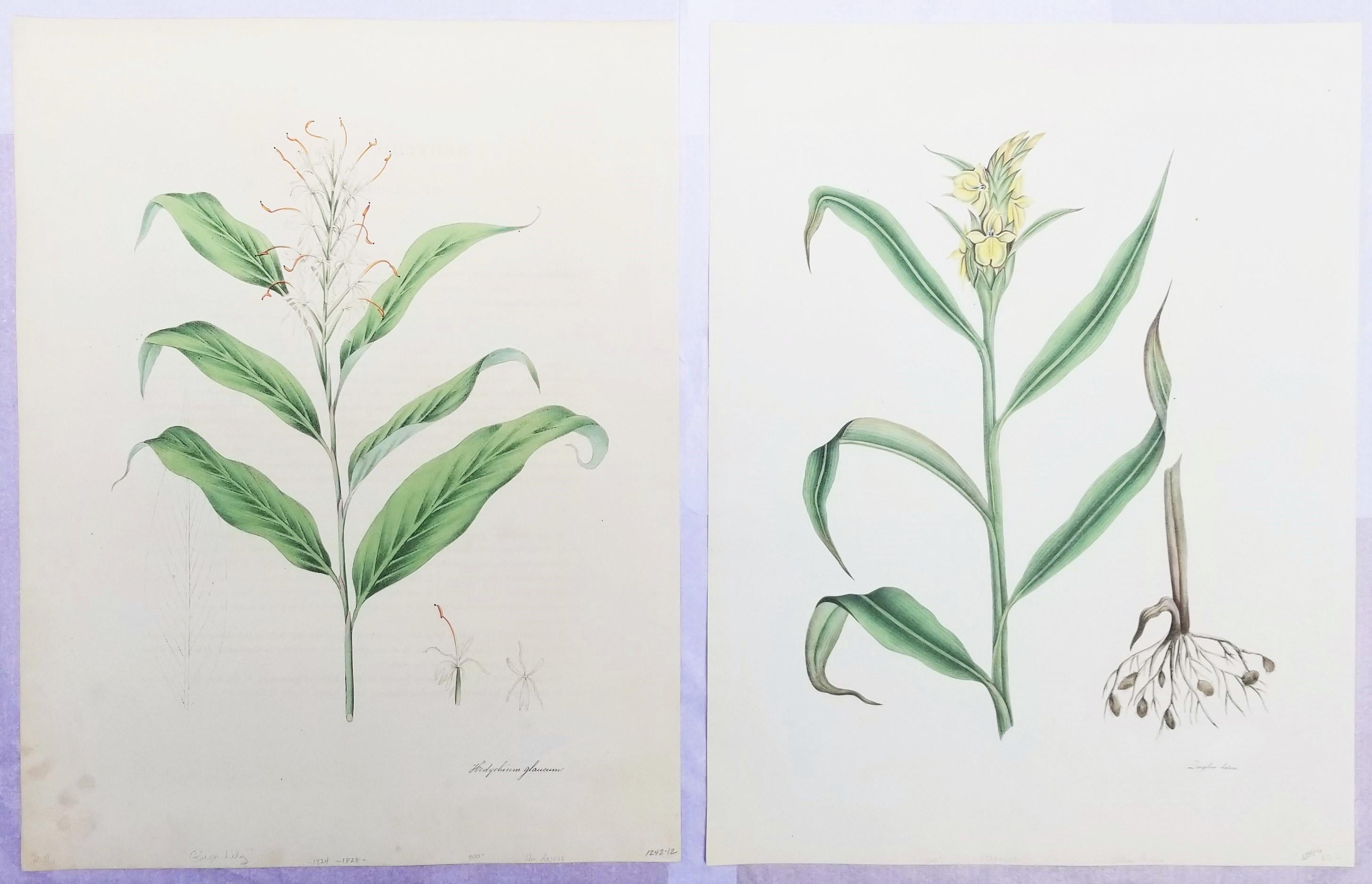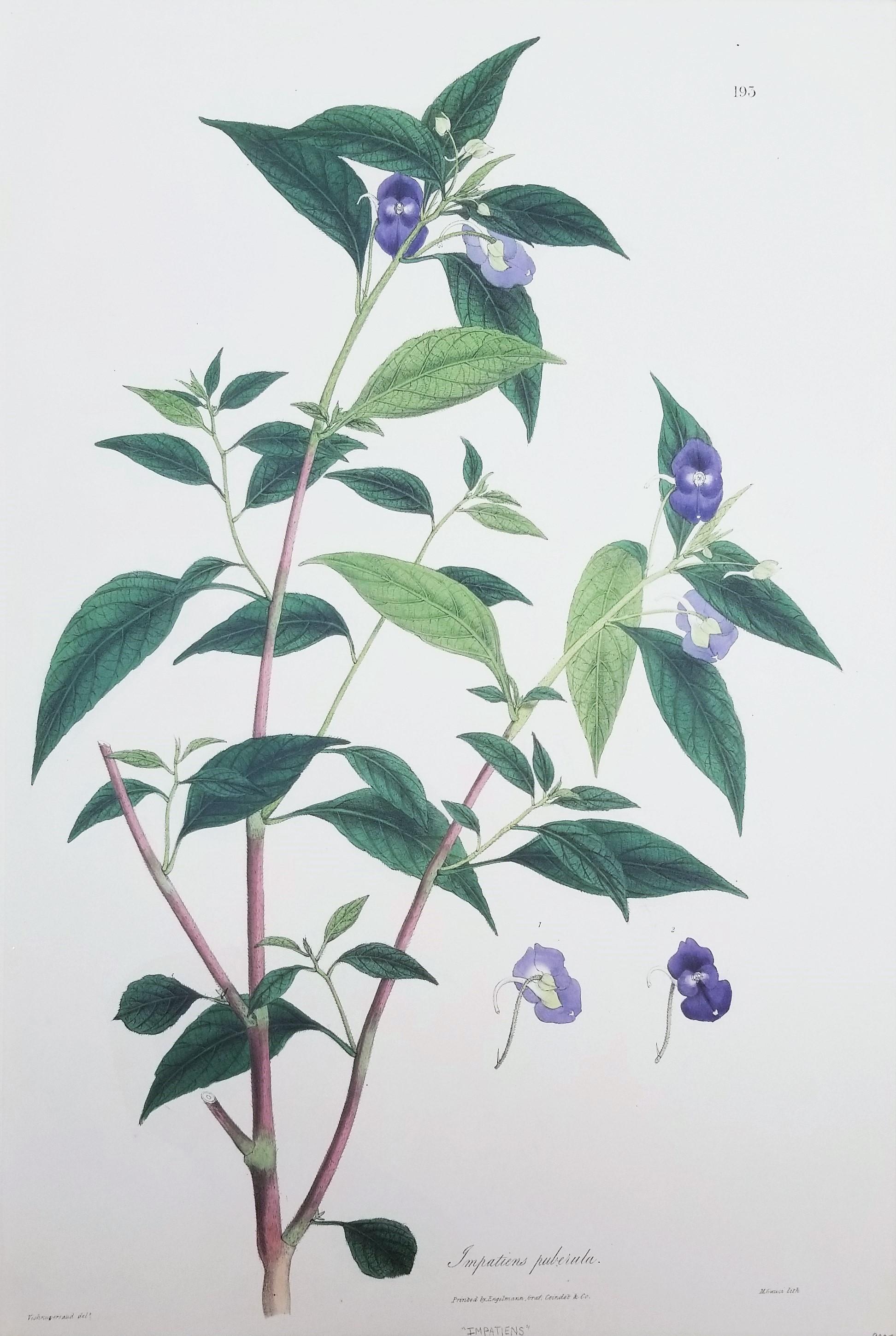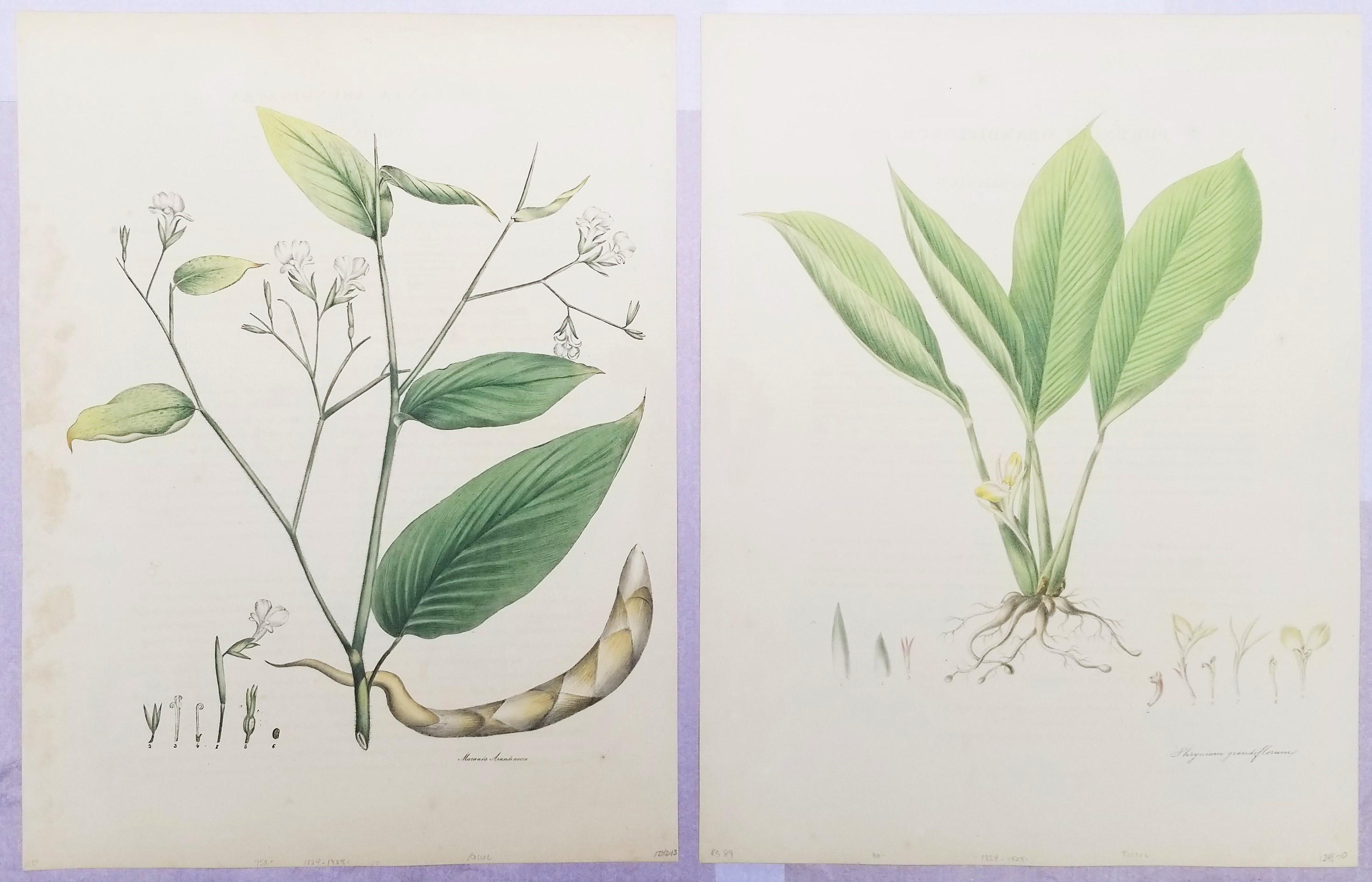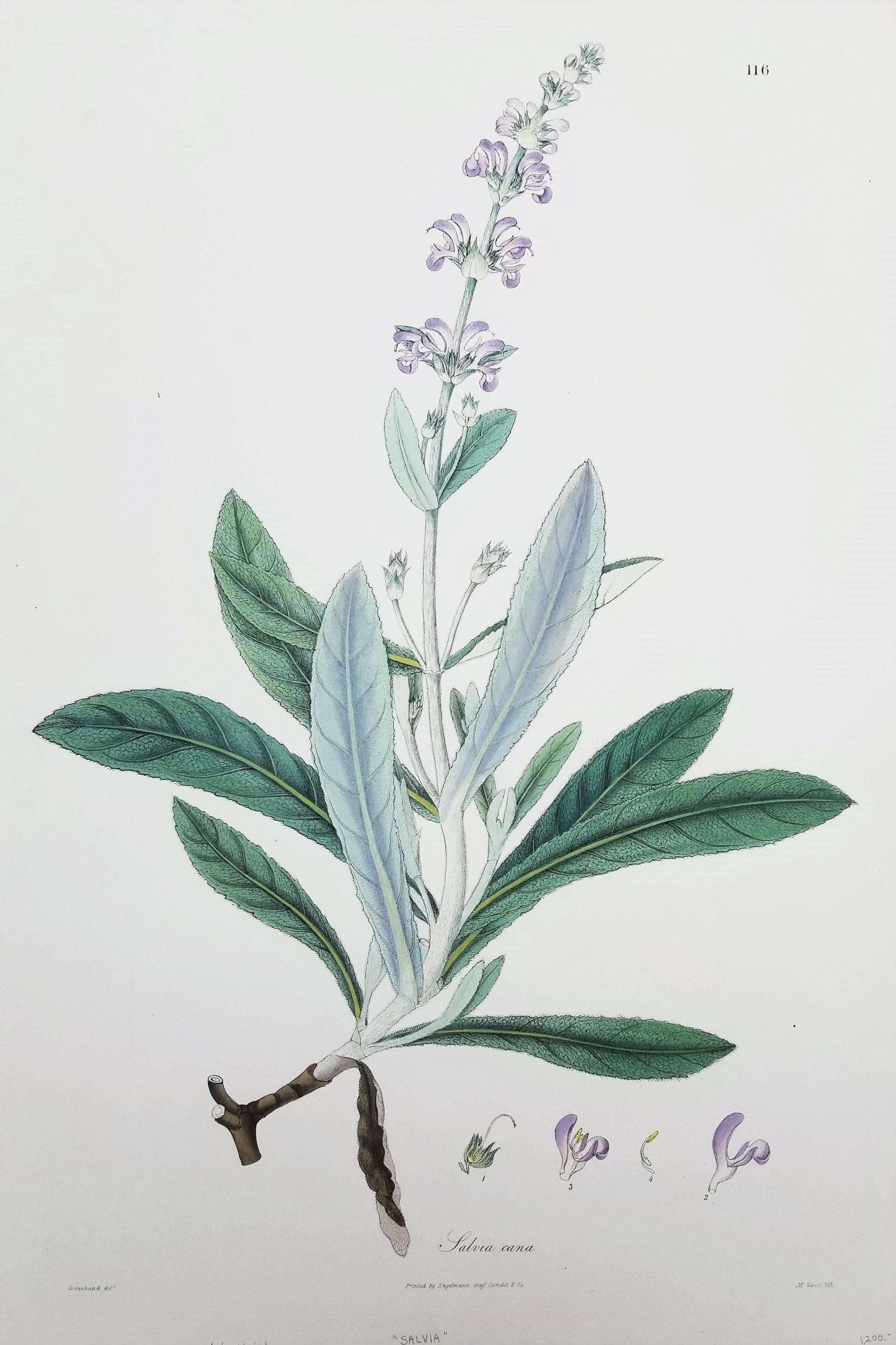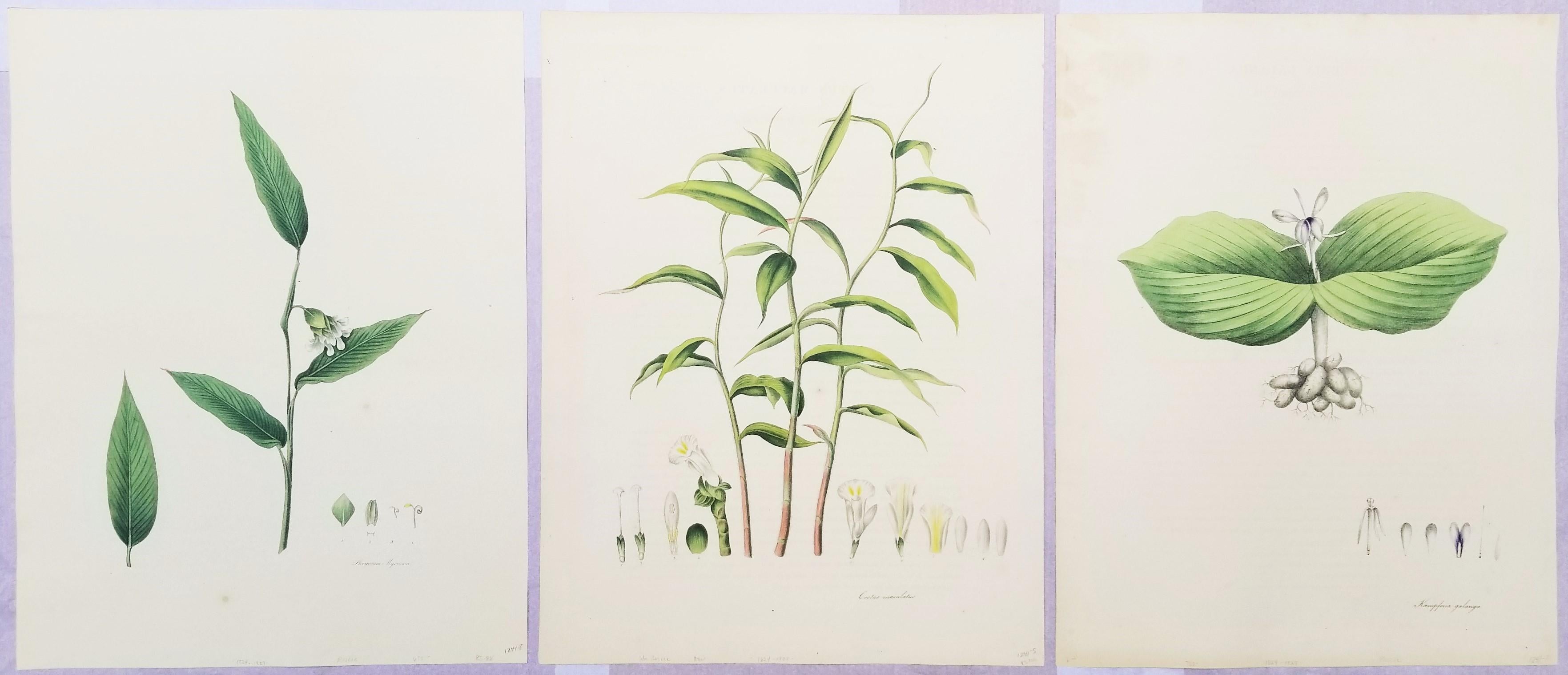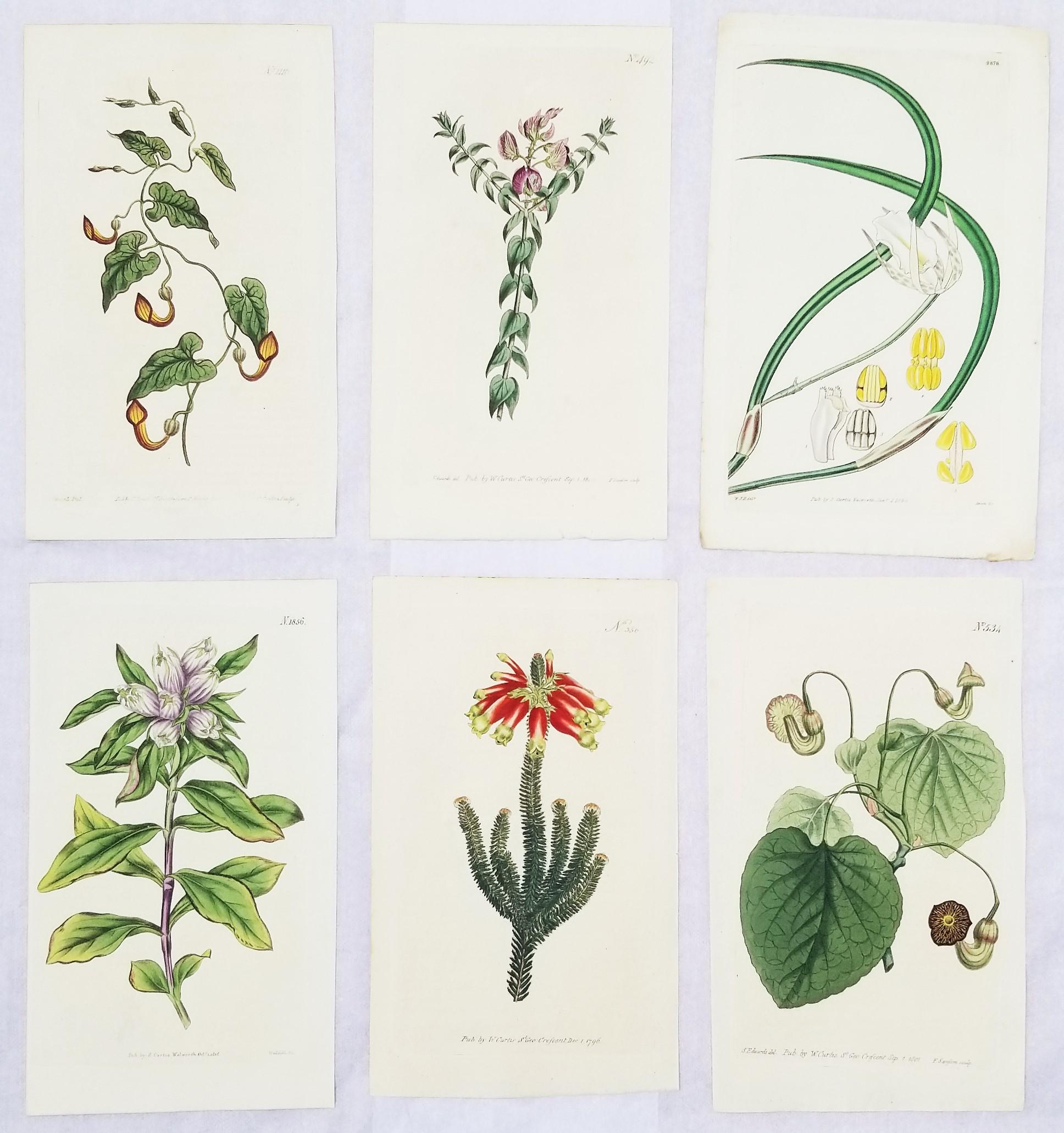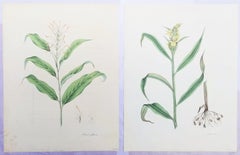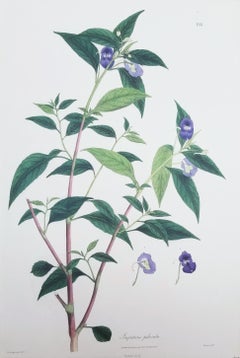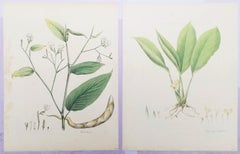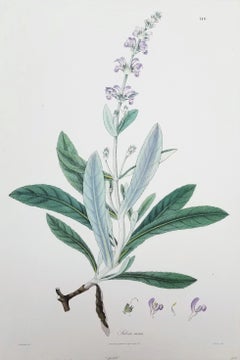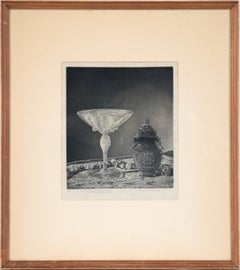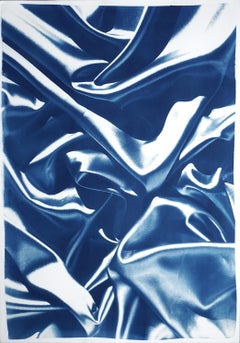Items Similar to Iris /// Antique Natural History Botany Botanical Flower Art Science Garden
Want more images or videos?
Request additional images or videos from the seller
1 of 20
Pierre Corneille Van GeelIris /// Antique Natural History Botany Botanical Flower Art Science Garden1828
1828
About the Item
Artist: Pierre Corneille Van Geel (Flemish, 1796-1838)
Title: "Iris"
Portfolio: Sertum Botanicum
Year: 1828 (first edition)
Medium: Original Hand-Colored Lithograph on wove paper
Limited edition: Unknown
Printer: Unknown
Publisher: Pierre Corneille Van Geel, Brussels, Belgium
Reference: Nissen No. 2386; Dunthorne No. 121
Framing: Not framed, but beautifully matted with handmade French matting. All archival
Matted size: 20" x 16"
Sheet size: 14.25" x 10.75"
Image size: 12" x 8"
Condition: Some minor toning to sheet. In otherwise excellent condition with strong colors
Very rare
Notes:
Comes from Van Geel's famous portfolio "Sertum Botanicum" (1828-1832), which consists of approx. 600 hand-colored prints, made from lithographed plates published in four volumes. Lithography by de Burggraaff after drawings by G. Severyns.
Biography:
Pierre Corneille Van Geel (Mechelen 1796 – Paris 1838), also P. C. Van Geel, was a Flemish writer, publisher, painter, and draughtsman.
Pierre Van Geel produced the lithographs for this publication, “Sertum Botanicum”, in 1828 from the drawings of G. Severyns. The publication contained approx. 600 illustrations, the majority of which were ornamental flowering plants recently introduced into cultivation. Unlike most artists of the day who relied mainly on specimens brought to Europe by overseas expeditions, few artists such as Van Geel, ventured abroad to study many of the more exotic flowers, including tropicals, that were up until then rarely captured on paper.
- Creator:Pierre Corneille Van Geel (1796 - 1838)
- Creation Year:1828
- Dimensions:Height: 20 in (50.8 cm)Width: 16 in (40.64 cm)
- Medium:
- Movement & Style:
- Period:
- Condition:
- Gallery Location:Saint Augustine, FL
- Reference Number:1stDibs: LU12125083462
About the Seller
5.0
Platinum Seller
Premium sellers with a 4.7+ rating and 24-hour response times
Established in 1978
1stDibs seller since 2015
1,307 sales on 1stDibs
Typical response time: <1 hour
- ShippingRetrieving quote...Shipping from: Saint Augustine, FL
- Return Policy
Authenticity Guarantee
In the unlikely event there’s an issue with an item’s authenticity, contact us within 1 year for a full refund. DetailsMoney-Back Guarantee
If your item is not as described, is damaged in transit, or does not arrive, contact us within 7 days for a full refund. Details24-Hour Cancellation
You have a 24-hour grace period in which to reconsider your purchase, with no questions asked.Vetted Professional Sellers
Our world-class sellers must adhere to strict standards for service and quality, maintaining the integrity of our listings.Price-Match Guarantee
If you find that a seller listed the same item for a lower price elsewhere, we’ll match it.Trusted Global Delivery
Our best-in-class carrier network provides specialized shipping options worldwide, including custom delivery.More From This Seller
View AllSet of Two Hand-Colored Lithographs from Roscoe's "Monandrian Plants" /// Botany
By William Roscoe
Located in Saint Augustine, FL
Artist: William Roscoe (English, 1753-1831)
Titles: "Hedychium Glaucum" and "Zingiber Elatum"
Portfolio: Monandrian Plants of the order Scitamineae, Chiefly Drawn from Living Specime...
Category
1820s Victorian Still-life Prints
Materials
Watercolor, Lithograph
Impatiens puberula (Soft Pink Balsam) /// Antique Botanical Flowers Plant Print
By Nathaniel Wallich
Located in Saint Augustine, FL
Artist: Nathaniel Wallich (Danish, 1786-1854)
Title: "Impatiens puberula (Soft Pink Balsam)" (Plate 193)
Portfolio: Plantae Asiaticae Rariores; or, Descriptions and Figures of a Select Number of Unpublished East Indian Plants
Year: 1830-1832
Medium: Original Hand-Colored Lithograph on J. Whatman paper
Limited edition: 254
Printer: Engelmann, Graf, Coindet & Co., London, UK
Publisher: Richard Taylor for Treuttel & Würtz, London, UK
Reference: Nissen BBI No. 2099; Pritzel No. 9957; Stafleu-Cowan No. 16583; Dunthorne No. 326
Sheet size: 21.13" x 14.13"
Condition: Has been professionally stored away for decades. In excellent condition with strong colors
Rare
Notes:
Provenance: private collection - Aspen, CO. Lithography by Maltese artist...
Category
1830s Victorian Still-life Prints
Materials
Watercolor, Lithograph
Set of Two Hand-Colored Lithographs from Roscoe's "Monandrian Plants" /// Botany
By William Roscoe
Located in Saint Augustine, FL
Artist: William Roscoe (English, 1753-1831)
Title: "Maranta Arundinacea (Arrowroot)" and "Phrynium Grandiflorum"
Portfolio: Monandrian Plants of the order Scitamineae, Chiefly Drawn ...
Category
1820s Victorian Still-life Prints
Materials
Watercolor, Lithograph
Salvia cana (Woolly Sage) /// Botanical Botany Flowers Plants Science Art Print
By Nathaniel Wallich
Located in Saint Augustine, FL
Artist: Nathaniel Wallich (Danish, 1786-1854)
Title: "Salvia cana (Woolly Sage)" (Plate 116)
Portfolio: Plantae Asiaticae Rariores; or, Descriptions and Figures of a Select Number of Unpublished East Indian Plants
Year: 1830-1832
Medium: Original Hand-Colored Lithograph on J. Whatman paper
Limited edition: 254
Printer: Engelmann, Graf, Coindet & Co., London, UK
Publisher: Richard Taylor for Treuttel & Würtz, London, UK
Reference: Nissen BBI No. 2099; Pritzel No. 9957; Stafleu-Cowan No. 16583; Dunthorne No. 326
Sheet size: 21.13" x 14.25"
Condition: Some scattered tiny handling creases to sheet. Has been professionally stored away for decades. In excellent condition with strong colors
Rare
Notes:
Provenance: private collection - Aspen, CO. Lithography by Maltese artist...
Category
1830s Victorian Still-life Prints
Materials
Watercolor, Lithograph
Set of Three Hand-Colored Lithographs from Roscoe's "Monandrian Plants"
By William Roscoe
Located in Saint Augustine, FL
Artist: William Roscoe (English, 1753-1831)
Title: "Phrynium Myrosma", "Costus Maculatus", and "Kaempferia Galanga (Aromatic Ginger)"
Portfolio: Monandrian Plants of the order Scitam...
Category
1820s Victorian Still-life Prints
Materials
Watercolor, Lithograph
Set of Six Hand-Colored Engravings from Curtis's Botanical Magazine /// Botany
By William Curtis
Located in Saint Augustine, FL
Artist: William Curtis (English, 1746-1799)
Title: Set of Six Hand-Colored Engravings
Portfolio: The Botanical Magazine; or, Flower-Garden Displayed
Year: 1796-1829 (First-third seri...
Category
1790s Victorian Still-life Prints
Materials
Watercolor, Engraving, Intaglio
You May Also Like
Ornamentale Tatowierung (Ornamental Tattoo) Antique Chromolithograph, circa 1895
Located in Melbourne, Victoria
'Ornamentale Tatowierung'
(Ornamental Tattooing)
German chromolithograph. 1895.
240mm by 150mm (sheet)
Category
Late 19th Century Victorian More Prints
Materials
Lithograph
"Crystal and Jade" Still Life Lithograph in Ink on Paper
By John Taylor Arms
Located in Soquel, CA
"Crystal and Jade" Still Life Lithograph in Ink on Paper
Delicate and detailed lithograph of a crystal glass and jade vase by John Taylor Arms (American, 1887-1953). On the left side of the composition, there is a crystal martini glass, with intricate designs. Next to it is a jade vase or urn, with a carved surface. They are sitting on an ornate tablecloth, with a strand of beads, possibly a rosary.
Numbered ("VI"), inscribed with a dedication ("To Georgiana Brewer and Jasper S. Mathews Jr from Dorothy and John Taylor Arms"), signed ("John Taylor Arms"), and dated ("1940") along the bottom edge.
Presented in a wood frame with an off-white mat.
Frame size: 16.5"H x 14.75"W
Image size: 8.5"H x 7.25"W
John Taylor Arms was born in Washington, DC in 1887. He studied law at Princeton University, transferring to the Massachusetts Institute of Technology, Boston, to study architecture, graduating in 1912. After serving as an officer in the United States Navy during World War I, he devoted himself full-time to etching. He published his first original etchings in 1919.
His initial subject was the Brooklyn Bridge in New York City near which he worked. Arms developed a successful career as a graphic artist in the 1920s and 1930s, specializing in series of etchings of Gothic churches and cathedrals in France and Italy. In addition to medieval subjects, Arms made a series of prints of American cities.
He used sewing needles and magnifying glasses to get a fine level of detail. A member of many printmaking societies, Arms served as president of the Society of American Graphic Artists. An educator, Arms wrote the Handbook of Print Making and Print Makers (1934) and did numerous demonstrations and lectures. Arms was elected into the National Academy of Design as an Associate member in 1930, and became a full member in 1933. His work was also part of the painting event in the art competition at the 1932 Summer Olympics...
Category
1940s Victorian Still-life Prints
Materials
Ink, Lithograph, Paper
Sculptured Marble in Classic Blue, Extra Large Cyanotype Print, Abstract Silk
By Kind of Cyan
Located in Barcelona, ES
This is an exclusive handprinted limited edition cyanotype.
Details:
+ Title: Marble Blue Silk Pattern
+ Year: 2022
+ Edition Size: 50
+ Medium: Cyanotype on Watercolor Paper
+ Sta...
Category
2010s Abstract Interior Drawings and Watercolors
Materials
Watercolor, Lithograph, Rag Paper, Emulsion
19th century color lithograph still life vase flowers
By Nathaniel Currier
Located in Milwaukee, WI
The present hand-colored lithograph is one of several decorative images of flower-filled vases published by Nathaniel Currier. This example contains roses, tulips, forget-me-nots, and others all within a vase with gold eagle head handles and an image of a beautiful young woman the belly.
16 x 11 inches, artwork
22.5 x 18.25 inches, frame
Entitled bottom center
Signed in the stone, lower left "Lith. and Pub. by N. Currier"
Inscribed lower right "152 Nassau St. Cor. of Spruce N.Y."
Copyrighted bottom center "Entered according to Act of Congress in the year 1848 by N. Currier in the Clerk's office of the Southern District of N.Y." with the number 249
Framed to conservation standards using 100 percent rag matting, housed in a lemon gold moulding.
Nathaniel Currier was a tall introspective man with a melancholy nature. He could captivate people with his piercing stare or charm them with his sparkling blue eyes. Nathaniel was born in Roxbury, Massachusetts on March 27th, 1813, the second of four children. His parents, Nathaniel and Hannah Currier, were distant cousins who lived a humble yet spartan life. When Nathaniel was eight years old, tragedy struck. Nathaniel’s father unexpectedly passed away leaving Nathaniel and his eleven-year-old brother Lorenzo to provide for the family. In addition to their mother, Nathaniel and Lorenzo had to care for six-year-old sister Elizabeth and two-year-old brother Charles. Nathaniel worked a series of odd jobs to support the family, and at fifteen, he started what would become a life-long career when he apprenticed in the Boston lithography shop of William and John Pendleton.
A Bavarian gentleman named Alois Senefelder invented lithography just 30 years prior to young Nat Currier’s apprenticeship. While under the employ of the brothers Pendleton, Nat was taught the art of lithography by the firm’s chief printer, a French national named Dubois, who brought the lithography trade to America.
Lithography involves grinding a piece of limestone flat and smooth then drawing in mirror image on the stone with a special grease pencil. After the image is completed, the stone is etched with a solution of aqua fortis leaving the greased areas in slight relief. Water is then used to wet the stone and greased-ink is rolled onto the raised areas. Since grease and water do not mix, the greased-ink is repelled by the moisture on the stone and clings to the original grease pencil lines. The stone is then placed in a press and used as a printing block to impart black on white images to paper.
In 1833, now twenty-years old and an accomplished lithographer, Nat Currier left Boston and moved to Philadelphia to do contract work for M.E.D. Brown, a noted engraver and printer. With the promise of good money, Currier hired on to help Brown prepare lithographic stones of scientific images for the American Journal of Sciences and Arts. When Nat completed the contract work in 1834, he traveled to New York City to work once again for his mentor John Pendleton, who was now operating his own shop located at 137 Broadway. Soon after the reunion, Pendleton expressed an interest in returning to Boston and offered to sell his print shop to Currier. Young Nat did not have the financial resources to buy the shop, but being the resourceful type he found another local printer by the name of Stodart. Together they bought Pendleton’s business.
The firm ‘Currier & Stodart’ specialized in "job" printing. They produced many different types of printed items, most notably music manuscripts for local publishers. By 1835, Stodart was frustrated that the business was not making enough money and he ended the partnership, taking his investment with him. With little more than some lithographic stones, and a talent for his trade, twenty-two year old Nat Currier set up shop in a temporary office at 1 Wall Street in New York City. He named his new enterprise ‘N. Currier, Lithographer’
Nathaniel continued as a job printer and duplicated everything from music sheets to architectural plans. He experimented with portraits, disaster scenes and memorial prints, and any thing that he could sell to the public from tables in front of his shop. During 1835 he produced a disaster print Ruins of the Planter's Hotel, New Orleans, which fell at two O’clock on the Morning of the 15th of May 1835, burying 50 persons, 40 of whom Escaped with their Lives. The public had a thirst for newsworthy events, and newspapers of the day did not include pictures. By producing this print, Nat gave the public a new way to “see” the news. The print sold reasonably well, an important fact that was not lost on Currier.
Nat met and married Eliza Farnsworth in 1840. He also produced a print that same year titled Awful Conflagration of the Steamboat Lexington in Long Island Sound on Monday Evening, January 18, 1840, by which melancholy occurrence over One Hundred Persons Perished. This print sold out very quickly, and Currier was approached by an enterprising publication who contracted him to print a single sheet addition of their paper, the New York Sun. This single page paper is presumed to be the first illustrated newspaper ever published.
The success of the Lexington print launched his career nationally and put him in a position to finally lift his family up. In 1841, Nat and Eliza had their first child, a son they named Edward West Currier. That same year Nat hired his twenty-one year old brother Charles and taught him the lithography trade, he also hired his artistically inclined brother Lorenzo to travel out west and make sketches of the new frontier as material for future prints. Charles worked for the firm on and off over the years, and invented a new type of lithographic crayon which he patented and named the Crayola. Lorenzo continued selling sketches to Nat for the next few years.
In 1843, Nat and Eliza had a daughter, Eliza West Currier, but tragedy struck in early 1847 when their young daughter died from a prolonged illness. Nat and Eliza were grief stricken, and Eliza, driven by despair, gave up on life and passed away just four months after her daughter’s death.
The subject of Nat Currier’s artwork changed following the death of his wife and daughter, and he produced many memorial prints and sentimental prints during the late 1840s. The memorial prints generally depicted grief stricken families posed by gravestones (the stones were left blank so the purchasers could fill in the names of the dearly departed). The sentimental prints usually depicted idealized portraits of women and children, titled with popular Christian names of the day.
Late in 1847, Nat Currier married Lura Ormsbee, a friend of the family. Lura was a self-sufficient woman, and she immediately set out to help Nat raise six-year-old Edward and get their house in order. In 1849, Lura delivered a son, Walter Black Currier, but fate dealt them a blow when young Walter died one year later. While Nat and Lura were grieving the loss of their new son, word came from San Francisco that Nat’s brother Lorenzo had also passed away from a brief illness. Nat sank deeper into his natural quiet melancholy. Friends stopped by to console the couple, and Lura began to set an extra place at their table for these unexpected guests. She continued this tradition throughout their lives.
In 1852, Charles introduced a friend, James Merritt Ives, to Nat and suggested he hire him as a bookkeeper. Jim Ives was a native New Yorker born in 1824 and raised on the grounds of Bellevue Hospital where his father was employed as superintendent. Jim was a self-trained artist and professional bookkeeper. He was also a plump and jovial man, presenting the exact opposite image of his new boss.
Jim Ives met Charles Currier through Caroline Clark, the object of Jim’s affection. Caroline’s sister Elizabeth was married to Charles, and Caroline was a close friend of the Currier family. Jim eventually proposed marriage to Caroline and solicited an introduction to Nat Currier, through Charles, in hopes of securing a more stable income to support his future wife.
Ives quickly set out to improve and modernize his new employer’s bookkeeping methods. He reorganized the firm’s sizable inventory, and used his artistic skills to streamline the firm’s production methods. By 1857, Nathaniel had become so dependent on Jims’ skills and initiative that he offered him a full partnership in the firm and appointed him general manager. The two men chose the name ‘Currier & Ives’ for the new partnership, and became close friends.
Currier & Ives produced their prints in a building at 33 Spruce Street where they occupied the third, fourth and fifth floors. The third floor was devoted to the hand operated printing presses that were built by Nat's cousin, Cyrus Currier, at his shop Cyrus Currier & Sons in Newark, NJ. The fourth floor found the artists, lithographers and the stone grinders at work. The fifth floor housed the coloring department, and was one of the earliest production lines in the country. The colorists were generally immigrant girls, mostly German, who came to America with some formal artistic training. Each colorist was responsible for adding a single color to a print. As a colorist finished applying their color, the print was passed down the line to the next colorist to add their color. The colorists worked from a master print displayed above their table, which showed where the proper colors were to be placed. At the end of the table was a touch up artist who checked the prints for quality, touching-in areas that may have been missed as it passed down the line. During the Civil War, demand for prints became so great that coloring stencils were developed to speed up production.
Although most Currier & Ives prints were colored in house, some were sent out to contract artists. The rate Currier & Ives paid these artists for coloring work was one dollar per one hundred small folios (a penny a print) and one dollar per one dozen large folios. Currier & Ives also offered uncolored prints to dealers, with instructions (included on the price list) on how to 'prepare the prints for coloring.' In addition, schools could order uncolored prints from the firm’s catalogue to use in their painting classes.
Nathaniel Currier and James Merritt Ives attracted a wide circle of friends during their years in business. Some of their more famous acquaintances included Horace Greeley, Phineas T. Barnum, and the outspoken abolitionists Rev. Henry Ward, and John Greenleaf Whittier (the latter being a cousin of Mr. Currier).
Nat Currier and Jim Ives described their business as "Publishers of Cheap and Popular Pictures" and produced many categories of prints. These included Disaster Scenes, Sentimental Images, Sports, Humor, Hunting Scenes, Politics, Religion, City and Rural Scenes, Trains, Ships, Fire Fighters, Famous Race Horses, Historical Portraits, and just about any other topic that satisfied the general public's taste. In all, the firm produced in excess of 7500 different titles, totaling over one million prints produced from 1835 to 1907.
Nat Currier retired in 1880, and signed over his share of the firm to his son Edward. Nat died eight years later at his summer home 'Lion’s Gate' in Amesbury, Massachusetts. Jim Ives remained active in the firm until his death in 1895, when his share of the firm passed to his eldest son, Chauncey.
In 1902, faced will failing health from the ravages of Tuberculosis, Edward Currier sold his share of the firm to Chauncey Ives...
Category
1840s Romantic Still-life Prints
Materials
Lithograph, Watercolor
Classic Botanical Cyanotype, Handmade Using Natural Sunlight, Limited Edition
By Kind of Cyan
Located in Barcelona, ES
This is an exclusive handprinted limited edition cyanotype.
Details:
+ Title: Vintage Pressed Flowers Nº3
+ Year: 2023
+ Edition Size: 20
+ Stamped and Certificate of Authenticity provided
+ Measurements : 70x100 cm (28x 40 in.), a standard frame size
+ All cyanotype prints are made on high-quality Italian watercolor paper
WHAT IS A CYANOTYPE?
The cyanotype (a.k.a. sun-print) process is one of the oldest in the history of photography, dating back to the 1840's.
Cyanotypes were then made famous by Anna Atkins, considered the first female photographer. Inspired by nature, we feel the need to look back at a craft that is handmade, analogue, and using an all-natural light source: the sun.
Our cyanotypes are made by coating high-quality Italian watercolor paper with a light-sensitive emulsion. We then expose it in direct sunlight for several minutes using a photo negative...
Category
2010s American Modern Still-life Prints
Materials
Emulsion, Watercolor, Paper, Lithograph
Lush Palm Bushes, Botanical Diptych, Still Life in Blue Tones, Tropical Style
By Kind of Cyan
Located in Barcelona, ES
This is an exclusive handprinted limited edition cyanotype.
"Lush Palm Bushes" is a gorgeous original cyanotype diptych showing gorgeous tropical palm leaves.
Details:
+ Title: Lu...
Category
2010s Art Deco Landscape Drawings and Watercolors
Materials
Lithograph, Watercolor
